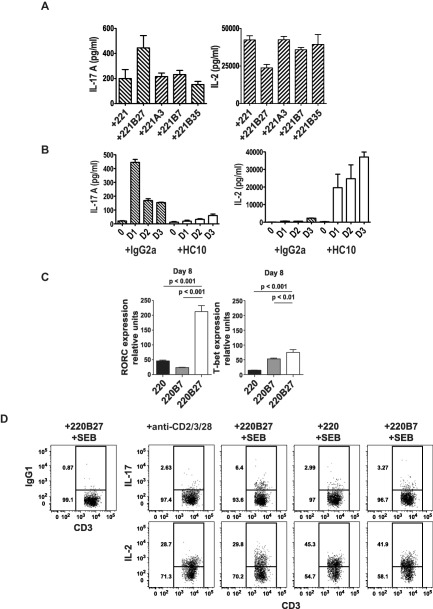Figure 5.

Interactions of KIR‐3DL2 with B27+ antigen‐presenting cells inhibit the production of interleukin‐2 (IL‐2) and promote Th17 cell differentiation. A, Secretion of IL‐17A and IL‐2 was assessed in CD4+ T cells from healthy controls (n = 6) cocultured for 5 days with LBL.721.221 cells (left nontransfected [221] or transfected with the indicated HLA class I molecules) and SEB. Values for T cells stimulated with LBL.721.221 B27+ cells were significantly different (P < 0.05 by analysis of variance) from those in T cells cocultured under the other conditions. B, Production of IL‐17A and IL‐2 was assessed in CD4+ T cells from healthy controls (n = 3) cocultured for up to 3 days with LBL.721.220 B27+ cells, SEB, and HC10 antibodies or IgG2a as isotype control. C, Expression of the retinoic acid receptor–related orphan nuclear receptor γt gene RORC and the T‐bet gene TBX21 was assessed in naive CD4+ T cells isolated from the peripheral blood of a healthy control after coculture with the indicated LBL.721.220 cells and SEB for 8 days. Gene expression was normalized to that of CD3. Representative results from 4 independent experiments are shown. In A–C, values are the mean ± SD. D, Representative flow cytometry plots show the proportions of viable IL‐17+ and IL‐2+ naive T cells after 5 days of stimulation with Th17 cytokines (IL‐1, IL‐6, and IL‐23) along with anti‐CD2/CD3/CD28 beads or with the indicated LBL.721.220 cells and SEB. IgG1 was used as the isotype control. See Figure 1 for other definitions.
